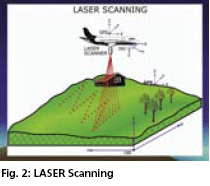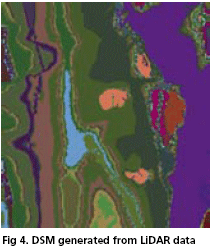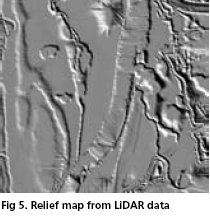| Mapping | |
Going hand in hand
|
|||||||||||||||
With the launch of GPS in the 1980s, the task of providing control points for mapping purposes was greatly simplified, leading to economy and ease of operation. The technique of LASER mapping, which existed decades before GPS, also received a boost due to GPS, as instantaneous precise positioning of the exposure station during the mobile LASER mapping operation was made possible by GPS, thus solving a major problem in LASER mapping. The recent GPS modernization programme, and the introduction of GNSS, an extension of GPS by addition of two more satellite systems, has further enhanced the utility of satellite positioning for mapping applications.
GPS modernization and GNSSGPS is the first surveying technique to offer applications in a very wide range of spheres, from mm-level high-precision geodesy to the few m-level real-time positioning, at an unprecedented speed and low cost. Continuing research efforts to improve the field data collection, orbit prediction, hardware and software developments and modelling and data processing have contributed towards making GPS the most widely used system of this century. The International GPS for Geodynamics Service (IGS) has proved the suitability of GPS for high-precision scientific tasks such as monitoring the crustal motions, the Earth rotation, etc. With the recently launched GPS modernization programme, to introduce a “civilian” code on L2 frequency, called L2C, and a third “civilian” frequency, called L5, the precision and integrity of GPS is likely to increase many-folds in the near future. The integration of GPS with the Russian System- GLONASS, and the new European system being launched: the GALILEO, the concept of integrated satellite-bases positioning and navigation through GNSS will soon become a reality. The GPS – International Navigation System (INS) integration, kinematic GPS survey techniques, psuedolites as substitute for GPS in the event of outages, the launching of Wide Area Augmentation Systems (WAAS) for civil aviation, etc. are some of the promising developments in this field, which will make the system most versatile and trust-worthy in the near future. LiDARThe Light Detection And Ranging (LiDAR) is a relatively new technological tool, which is very useful for terrain mapping, and hence, widely accepted around the world. This technology is also known as Airborne Laser Terrain Mapping (ALTM), Airborne Swath Mapping (ASM), Airborne Laser Mapping (ALM) or Airborne Laser Scanning (ALS). LiDAR is much faster than conventional photogrammetric technology and the data is easily combined with other type of data, through many commercial software products, for numerous applications. Its development goes back to 1970s and 1980s, with the introduction of the early NASA-LiDAR systems, and other attempts in USA and Canada (Ackermann, 1999). The method has successfully established itself as an important technique, within a few years, and quickly spread into practical applications. By the early 1980s, second generation LiDAR systems were in use around the world. These were expensive and had limited capability, and were generally used only by federal agencies in USA. With the enhanced computer power currently available, and with the latest positioning and orientation systems, including GNSS, LiDAR systems have become a commercially viable alternative for development of Digital Elevation Models (DEMs) of earth surface. LiDAR can be useful for collection of elevation data in case of dense forests, where photogrammetry fails to reveal the accurate terrain information, due to dense canopy cover. Not limited by the environmental conditions restricting aerial photography, airborne laser scanning technology is emerging as an attractive alternative to the traditional technology for large-scale geospatial data capture LiDAR data collectionA pulsed laser ranging system is mounted in an aircraft equipped with a precise kinematic GPS receiver and an Inertial Navigation System (INS). By accurately timing the round trip travel time of the light pulses from the aircraft to the ground (water, foliage, buildings or other surface features), it is possible to determine the range with a precision of one centimeter or better. Solid-state lasers are now available that can produce thousands of pulses per second, each pulse having a duration of a few nanoseconds (10- 9 seconds). Using a rotating mirror inside the laser transmitter, the laser pulses can be made to sweep through an angle, tracing out a line on the ground. By reversing the direction of rotation at a selected angular interval, the laser pulses can be made to scan back and forth along a line. When such a laser ranging system is mounted in an aircraft with the scan line perpendicular to the direction of flight, it produces a saw tooth pattern along the flight path as shown in figure 2. The width of the strip or “swath” covered by the ranges, and the spacing between measurement points, depends on the scan angle of the laser ranging system and the airplane height. Using a light twin or single engine aircraft, typical operating parameters are: flying speeds of 200 to 250 kilometers per hour (55 to 70 meters per second), flying heights of 300 to 1000 meters, scan angles generally ±30, to ±20 degrees, and pulse rates of 2000 to 50000 pulses per second. These parameters can be selected to yield a measurement point every few meters, with a footprint of 10 to 15 centimeters, providing enough information to create a Digital Terrain Model (DTM) adequate for most applications, including the mapping of storm damage to beaches, in a single pass. The primary factor in the final DTM accuracy is the airborne GPS data. Errors in the location and orientation of the aircraft, the beam director angle, atmospheric refraction model and several other sources degrade the co-ordinates of the surface point to 5 to 10 centimeters (Shrestha and Canter, 1998). After a flight, the precise position of the aircraft at the exact epoch of each range measurement is computed relative to nearby GPS ground stations using phase differenced kinematic Global Positioning System (DGPS) techniques. The laser ranging vectors are added to the aircraft positions to derive three dimensional X,Y,Z coordinates of each ground point. Because airborne GPS data is critical to overall accuracy, flight layouts should optimize the GPS component. To ensure desired accuracies, the use of six satellites at all times during the data-collection is preferred, although solutions can be delivered with a minimum of four satellites. Further, ground-reference receivers should be located every 15 kilometers to 20 kilometers. Comparison with other techniquesLiDAR is an emerging technique for data collection and is found to be very accurate and suitable, as compared to the currently available techniques, like photogrammetry and RADAR. Until recently, only conventional techniques of topographic data collection (viz. Surveying, levelling, photogrammetry, satellite stereogrammetry etc.) were available to the geomatics community. These techniques suffer from one or other limitation in terms of their accuracy, resolution, time, site inaccessibility, weather and sunlight dependence, etc. LiDAR, however, promises to eliminate most of the handicaps of conventional methods, and is establishing itself as a major player in the topographic, data collection industry. LiDAR is an active illumination sensor; a laser system can collect data at night and can be operated in the any weather and at low sun angles, that prohibit aerial photography. With LiDAR, DTM can be generated more rapidly and accurately than with photogrammetry, due to digital acquisition of the data and the direct range measurement. Calculations show that LiDAR requires only 25% to 33% of the budget as compared to photogrammetric compilation (Petzold et al., 1999). Interferometric Synthetic Aperture Radar (InSAR) is a new and rapidly evolving technique useful for DEM generation, which seems to be competitor of LiDAR in resent years. But the accuracies achieved so far by InSAR are usually in the range of 1 meter, on the contrary, LiDAR gives vertical accuracies in the range of 10 to 15 centimeters, which is well tested by conducting number of pilot projects in various countries around the world. Layovers is a major problem in INSAR, creating lots of problems in generating accurate DTM, especially in the hilly terrain with wide variation in topography, and in urban areas with skyscrapers, which introduce significant errors. On the contrary, LiDAR is not affected by layovers and shows promising results. DTM generation from LiDARLiDAR data is useful for generating Digital Elevation Model (DEM) and relief maps. DEM gives the height information and three-dimensional view of the topography. This information is very much useful in various engineering and military application. The X,Y,Z coordinates of the ground points can be processed using a number of commercially available software packages to produce a DEM, and many other products such as shaded relief maps, contour maps, cross sections and surface profiles.The ASCII data collected by LiDAR can be imported into software like Arc-view, Microstation, etc., to represent into point format. After initial editing, the contours can be generated by using software like Terramodel, GRAM++ and Arcinfo. After interpolating contour data into the software, Digital Surface Model (DSM) and shaded relief map can be generated from this data (see figure 4). The shaded relief map of the area shown in figure 5 is generated by using GRAM++ GIS package, developed by Centre of Studies in Resource Engineering (CSRE), IIT Bombay. ApplicationsLiDAR has numerous applications in various engineering fields; some of which are quite unique. Some of the important LiDAR applications are described here. Beach MappingHighly accurate, dense and rapidly obtained data sets are most suitable for coastal applications like sediment transport, coastal erosion and coastal flood models. This new capability opens for the first time the possibility to regularly monitor the beaches, to map just prior to and immediately after major storms, to obtain accurate quantitative information about the extent of the damage (Shrestha and Canter, 1998). Forest studiesLaser-based LiDAR systems offer distinct advantages over existing survey instruments in areas such as forest surveys. A unique advantage of these instruments is that they are capable of penetrating vegetation, allowing the ground beneath a tree canopy to be mapped directly from the air. Infrastructure construction, maintenance, and managementLiDAR can also be effectively employed for corridor mapping to plan oil and gas pipelines, and for their post -commission maintenance. The tasks from the field survey to the final data delivery can be accomplished within weeks, which otherwise, using the conventional methods, would take months. LiDAR is useful in generating DTM for road planning and design (Janssen and Gomes, 1999). Transmission Lines MappingLong stretches of transmission lines can be mapped with great speed, to determine the exact location of the transmission towers, accurate topography of the corridor, and the encroachment by vegetation for modification and repair purposes (Lohani, 2000). Architecture and landscape design/ Three- dimensional modelingAutomatic integration of an architectural design with its surrounding, represented by a highresolution 3D landscape model obtained by LiDAR, that includes existing vegetation, facilitates the design process and gives an accurate impression of how your design interacts with its surrounding. Disaster prevention and responseLiDAR is very helpful to determine areas prone to natural hazards like floods, and to rapidly assess the damage to infrastructure after natural disasters like earthquakes, storms, and landslides on a larger scale. Other applications of LiDAR• Landslide Mapping • Volcano monitoring • Bathymetry • Urban planning and development • Ecology and environment Integration of photogrammetry and LiDARThe combination of aerial photography and LiDAR has great potential. Results and performance could certainly be enhanced, if laser scanning system is supplemented by taking aerial photographs. One can imagine the benefits of high-resolution imagery and a dense LiDAR-generated DEM. The LiDAR DEM tends to be much denser that those available through current sources. This potentially leads to more accurate orthorectification. The user enjoys the benefits of high spatial resolution from the imagery and a very accurate, dense DEM from the LiDAR system. For more details, see (Satale, 2003). International and Indian scenarioLiDAR is commercially operational in various countries like USA, Canada and in Europe. A few LiDAR projects have been taken up in India recently, mostly on pilot basis. In India, there are many of ongoing and proposed projects related to roadways, railways, oil and gas pipelines, electric transmission lines, communication network, ports and harbors, for which speedy collection of accurate topographic data is an important factor, which reduces the cost of the entire project dramatically. Delays in project work due to the limitations of conventional data collection approaches may also be minimized, by using technologies like LiDAR. India is prone to natural disasters of varied forms, resulting in heavy losses of life and wealth. LiDAR data have the potential to be effective in many disaster management programs, including the frequently occurring floods, like the Mumbai floods of July, 2005. The LiDAR technology can be very effectively used for such important applications. ConclusionsThe main advantages of LiDAR are accuracy of measurements, high automation and fast delivery times. Due to its typical characteristics, both in data collection and data type, LiDAR has opened up several new applications, which were not economically feasible with the conventional techniques. In India the technology is yet to make its impact on the mapping, and has still a long way to go. Looking at the potentials of this technology, it is obvious that LiDAR will play a major role in geospatial applications in near future. AcknowledgementsThe research work related to comparison of photogrammetry and LiDAR was carried out by the second author, under the guidance of the first author, as part of M.Tech. thesis. References[1] Ackermann, F., Airborne laser scanning present status and future expectations. ISPRS Journal of Photogrammetry & Remote Sensing, Vol. 54, pp. 148,1999. [2] Janssen, L.L.F., Gomes, L.M., Suitability of laser data for DTM generation: a case study in the context of road planning and design, International Journal of Remote Sensing, Vol.54, pp. 244, 1999. [4] Lohani, B., Airborne Altimetric LiDAR. GIS at Development, Vol. 4, pp 19, 2000. [5] Petzold, B., Reiss, P., Stolssel, W., Laser scanning- surveying and mapping agencies are using a new technique for the derivation of digital terrain models, ISPRS Journal of Photogrammetry Engineering and Remote Sensing, Vol. 54, pp. 95, 1999. [6] Satale, Dhananjay M., LiDAR in Mapping, M.Tech. Dissertation, Department of Civil Engineering, I.I.T. Bombay, 2003 [7] Shrestha, R., Carter W. E., Engineering applications of airborne scanning lasers:Reports from the field. Journal of Photogrammetry Engineering and Remote Sensing,Vol. 66, pp.256, 1998. |
|||||||||||||||
|
|||||||||||||||
|


















 (No Ratings Yet)
(No Ratings Yet)




